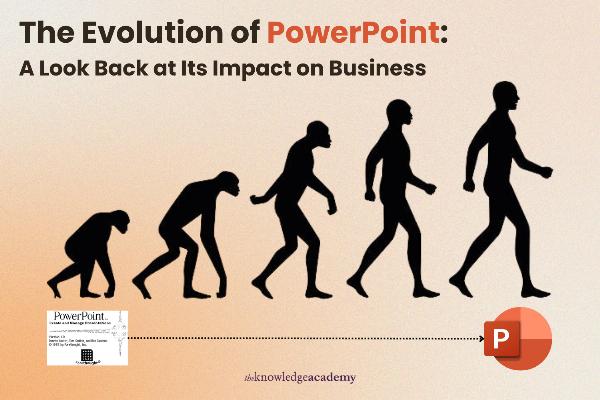The Evolution of PowerPoint: A Look Back at Its Impact on Business

When delving into the realm of business presentations, one cannot overlook the monumental influence of Microsoft PowerPoint. Initially released over three decades ago, this tool has not just survived but thrived in the ever-evolving landscape of technology.
But What is PowerPoint? At its core, it's a software designed to help users create and display digital presentations, comprising slides that can contain text, images, and other multimedia. Its introduction marked a pivotal shift in how information is presented in the corporate world, transforming monotonous meetings into dynamic discussions.
As we explore its journey in this blog, we'll uncover how PowerPoint has shaped and been shaped by the business sector.
Table of Contents
- The Origins of PowerPoint
- PowerPoint's Role in Business Communication
- The Evolution of Features
- Criticisms and Controversies
- PowerPoint Today and Tomorrow
- Conclusion
The Origins of PowerPoint
The story of PowerPoint begins in 1987, with its initial release by Forethought, Inc. This was a time when presentations were predominantly slide-based, using overhead projectors. PowerPoint introduced a digital alternative, providing tools to create slides with ease, which could be projected from computers. This innovation was a game changer, enabling businesses to prepare more visually appealing and detailed presentations.
PowerPoint's Role in Business Communication
PowerPoint quickly became a staple in business environments around the globe. Its impact on communication was profound, offering a way to effectively share complex data and strategic insights through charts, graphs, and diagrams. This ability to visually simplify complex information made it an invaluable tool for decision-making processes.
- Enhancing Audience Engagement: PowerPoint allowed for the integration of multimedia elements, which made presentations more engaging and interactive. This was crucial in maintaining audience attention and facilitating better understanding.
- Standardising Presentations: It provided a framework that helped maintain consistency in branding and messaging across the corporate spectrum, ensuring that every presentation adhered to certain standards and styles.
- Facilitating Remote Presentations: As remote work gained traction, PowerPoint proved essential in bridging geographic gaps, enabling presenters to connect with audiences worldwide through webinars and virtual meetings.
- Training and Education: It has also played a crucial role in training and educational settings, providing trainers and educators with a tool to create informative and digestible training materials and lessons.
- Sales and Marketing: PowerPoint has become a fundamental tool in sales and marketing strategies, allowing teams to craft compelling stories and pitches that capture potential clients' interests and clearly demonstrate product benefits.
The Evolution of Features
Over the years, PowerPoint has undergone numerous updates to keep up with the needs of its users and advancements in technology. Each version brought new features that aimed to enhance usability and functionality:
- Integration with Other Tools: Integration with tools like Excel and Word streamlined the workflow, allowing for seamless data and content updates.
- Collaboration Features: The introduction of collaborative features meant that teams could work on presentations simultaneously, enhancing productivity and fostering a more collaborative environment.
- Enhanced Customisability: Over the years, PowerPoint has expanded its range of customisable templates and animations, allowing users to tailor their presentations more precisely to their audience's expectations and the presenter's personal style.
- Accessibility Features: Recent versions have focused on increasing accessibility, introducing features like subtitles for videos and better screen reader support, ensuring presentations are inclusive for all audiences.
- Mobile Compatibility: With the rise of mobile computing, PowerPoint has optimised its functionality for mobile devices, allowing users to create, edit, and present directly from their smartphones and tablets.
Criticisms and Controversies
Despite its widespread use, PowerPoint has not been without criticism. Critics argue that its template-based approach can oversimplify complex subjects, leading to a phenomenon known as "Death by PowerPoint," where audiences are overwhelmed with slides full of bulleted lists and minimal data interpretation.
PowerPoint Today and Tomorrow
Today, PowerPoint continues to evolve, embracing new trends such as cloud-based collaboration and AI-driven design suggestions. As businesses look towards more interactive and data-driven presentation tools, PowerPoint's ability to adapt will be crucial to its sustained relevance.
- Interactive Presentations: With the rise of remote working, PowerPoint has adapted by integrating more interactive elements, such as live polls and Q&A sessions.
- AI Enhancements: AI technologies are being used to improve design aesthetics and automate repetitive tasks, making the tool more efficient and user-friendly.
- Virtual Reality Integration: PowerPoint is poised to integrate with virtual and augmented reality, providing immersive presentation experiences that captivate audiences uniquely.
- Promoting Sustainability: It is promoting sustainability by encouraging paperless presentations and reducing traditional presentation methods' environmental impact.
- Incorporating Advanced Analytics: Upcoming versions are expected to feature advanced analytics, enabling presenters to gauge audience engagement and feedback in real time, allowing for dynamic adjustments to content and delivery.
Conclusion
Reflecting on the evolution of PowerPoint, it's clear that its impact on business communication is indelible. From revolutionising how presentations are created and delivered to adapting to new technological paradigms, PowerPoint has shown a remarkable ability to grow and remain relevant. As we look to the future, the continued innovation of this tool will undoubtedly play a key role in shaping how business information is conveyed and comprehended.
Note: IndiBlogHub features both user-submitted and editorial content. We do not verify third-party contributions. Read our Disclaimer and Privacy Policyfor details.







